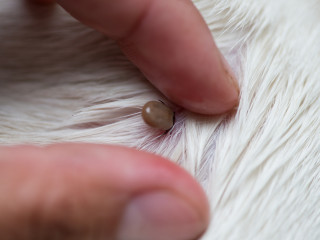
Ticks on dogs
- There are hundreds of species of ticks around the world.
- Several can be found in the UK, especially in spring and summer.
- While they can be found all year round, their numbers increase between March and November when temperatures rise.
What does a tick look like on a dog?
Ticks can vary in size from 1mm up to 1cm long. Small ticks can be difficult to spot. They usually become obvious when you run your hand over your dog’s head, ears, neck or feet and spot a small lump that wasn’t there before (although they can latch on to any part of the body where there is a good blood supply). Ticks on dogs typically have a cream-coloured, oval body that turns darker as it fills with blood.

How to get rid of ticks on dogs?
Following the steps below should allow you to remove a tick from your dog safely:
- Groom your dog regularly to check for infestations.
- If you do find a tick NEVER try to pull or scrape it off using your fingernails.
- Instead, buy a claw-shaped tick remover tool from your daytime vet or local pet shop.
- Follow the instructions carefully.
- Be sure not to break off the head of the tick so it’s left under the skin.
- If you do break off the head by accident call your vet for advice.
You might also be interested in:
Disposing of ticks on dogs
Once you’ve successfully managed to remove the tick from your dog, be sure to have a sealed jar or container on hand to place it in. Ticks carry dangerous diseases and should be killed and disposed of carefully. You should also clean the affected area on your dog thoroughly. If you have any concerns, talk to your vet immediately.
How to prevent ticks on dogs
If you walk in areas likely to be infested by ticks, such as woodland, heathland and moor, then speak to your vet as there are many products available that repel and kill ticks.
Where do ticks live?
Ticks in the UK are typically found in grassland, scrub, shrubs and on low-hanging tree branches. They tend to climb on board an animal when they brush against them.
There is some evidence to suggest an increasing prevalence of the tiny blood-sucking creatures in the UK. This is probably a result of climate change, and the increased movement of people and their pets between countries.
How long do ticks survive?
Female ticks lay eggs each spring. They can lay around 2000, which are tiny (0.7mm long). After laying their eggs, female ticks shrivel and die. Tick eggs hatch as six-legged larvae in the summer of the same year they are laid. They’re about the size of a full stop.
The larvae remain inactive until the following spring when they climb grass shoots or trees and wait for a host such as a dog, cat, mouse, squirrel, rabbit, bird, deer, cow or sheep to pass. They then spend up to a week sucking the blood of their host, before falling to the ground.
A year later they re-emerge to search for another host to latch on to. This time they feed for up to 11 days before detaching and falling to the ground. At this point, the tick matures into an adult.
Once again, the tick will remain inactive until the following spring, when they’ll start their third and final search for another host. Once they find it, adult female ticks will feed for between eight and 12 days. During this feeding frenzy, their weight will increase by as much as 100 times before they lay their eggs and die off. The three-year tick cycle will then start all over again.
What diseases can my dog get from ticks?
Ticks are known as “vectors” for disease transmission. This means they can carry micro-organisms that can cause diseases in both animals and humans, from one animal to another. Diseases are passed when the ticks feed. For ticks to transmit disease, they must first feed on an infected animal.
Lyme disease
This is an inflammatory disorder, which can become chronic if left untreated. Lyme disease is caused by a bacterium (Borrelia burgdorferi) that the tick carries. Humans can get the disease if they are bitten by an infected tick.
In dogs, the most obvious signs of Lyme disease include a distinctive “bull’s eye” lesion around the site of the bite, lameness, inflamed lymph nodes and fever.
Symptoms of Lyme disease in humans are flu-like, including extreme tiredness, muscle pain, muscle weakness, joint pain and headaches. They can also include stomach ache, poor sleep, disturbances of the central nervous system and the distinctive “bull’s eye” rash.
If you or your pet suffer any compatible clinical signs such as stiffness, lethargy, change in mood, or unusual skin lesions, you should contact a doctor or vet immediately.
Ehrlichiosis
Ehrlichiosis is a tick-borne disease of the white blood cells, caused by infection with a rickettsial bacteria called Ehrlichia spp. People can catch Ehrlichiosis as a result of being bitten by an infected tick, but this is rare with only around 10-20 confirmed cases per year in the UK.
In dogs, the signs of Ehrlichiosis can include fever, anorexia, weight loss, stiffness and prolonged bleeding.
Ehrlichiosis does not normally occur in the UK. However, it is common in Europe, the USA and Africa, and there is a risk:
- to pets that travel to these areas
- that travelling pets may return to the UK with this disease, and help it establish here
Babesiosis
Babesiosis is a disease of the red blood cells caused by infection with the tick-borne parasite, Babesia spp. Human cases are rare with only 10-20 cases reported per year.
In dogs, the signs of Babesiosis can include loss of appetite, fever, anaemia, weakness and coffee-coloured urine. It can be fatal.
Babesiosis does not normally occur in the UK. However, it is common in Europe, Africa and Asia, and there is a risk:
- to pets that travel to these areas
- that travelling pets may return to the UK with this disease, and help it establish here
Can dog owners get Lyme disease from ticks?
Yes. While there’s no evidence of dogs spreading the disease to their owners directly, they can bring disease-carrying ticks into people’s homes. As is the case with dogs, if you’re bitten by a tick, use a purpose-built hook to remove it. If you try to pull the tick out directly you risk leaving part of its head or mouth inside your body. You should contact your doctor urgently if you experience flu-like symptoms or a rash after being bitten by a tick, or if the bite becomes infected.
How to avoid being bitten by a tick?
The simplest advice is to use insect repellant and avoid exposing your skin while out for a walk. In other words, wear long-sleeved tops, long socks and a hat. You should also regularly check your clothes for ticks and brush off any you find immediately.

